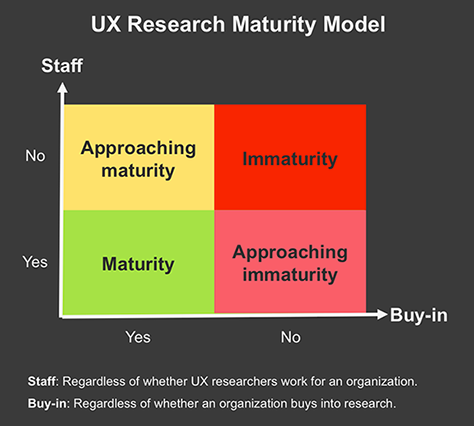UX Research Maturity Model
Several maturity models for human-centered design and usability exist in the literature. [1, 2, 3] The UX research maturity model shown in Figure 1 is based on an organization’s level of buy-in for UX research in combination with the presence of UX research staff within an organization.

The four quadrants of this model are as follows:
- Maturity—both buy-in and staff—An organization believes in UX research, fully trusts UX research practice—whether in house or external—and behaves in a manner that is consistent with that belief. These are the rare organizations that truly get it. They have a deep understanding of and appreciation for UX research, and they back it up with action. They ask potential customers all the right questions to understand what they need, and they iterate and validate their designs to perfection. Fight or flee? Neither. You won’t need to fight, and there is no reason to flee. All is well.
- Approaching maturity—buy-in, but no staff—An organization states that UX research is important, but when it comes to action, there is no staff to act upon that policy. An organization may have hired consultants to do some ad hoc research in the past and plans to hire their first full-time user experience researcher or a research team in the near future. Fight or flee? Neither. This type of organization is currently taking baby steps in the right direction. Join this organization when it hires new people or transfer to an internal UX research position if you already work there in a different role.
- Approaching immaturity—no buy-in, but there is staff—An organization employs UX research staff, but does not really buy into what they do, discover, and recommend. This type of organization is probably the hardest for UX researchers and other UX professionals to work in. It’s extremely frustrating for UX professionals to work in an environment that sends contradictory messages. On one hand, the organization appreciates UX design and research because it allocates headcount and hires the right people. On the other hand, it is evident that there is no appreciation for this discipline. The organization makes design decisions based on the wrong considerations, and stakeholders do not empower UX designers and researchers to do their jobs. Fight or flee? To an extent, it’s worthwhile to fight, but if the organization doesn’t mature, flee.
- Immaturity—no buy-in or staff—An organization does not believe in UX research—or has no position regarding research—and does not employ any in-house or external research practitioners. It’s probably easiest to know what to do in this type of organization. As Frank Costanza once said, “If they don’t want me, I don’t want them”—from a Seinfeld episode from 1996, “The Doll.” Such organizations should not—and usually do not—get the attention of UX professionals. Maybe they’ll get it eventually, maybe not. Chances are that they will someday. Until then, it’s a waste of time to even try working with them. Fight or flee? Hopefully, neither. You’re probably not working for one of these organizations.
Consultants Avoid Immature Organizations
Many consultants have the privilege of choosing their clients, deciding whether to work with certain clients and stakeholders. In many cases, clients that approach consultancies are already persuaded that user-centered design is what they need, so consultants need not make a big effort to persuade them to buy into UX research. In his article, “Why I Can’t Convince Executives to Invest in UX (And Neither Can You,”![]() Jared Spool speaks about this reality. As does Donna Spencer, in my interview with her, shown in Figure 2. They don’t try to convince those who can’t be convinced.
Jared Spool speaks about this reality. As does Donna Spencer, in my interview with her, shown in Figure 2. They don’t try to convince those who can’t be convinced.
